NCS 2202 Culture and Health: A Reflective Essay on Aboriginal Patient
VerifiedAdded on 2023/06/03
|11
|3248
|238
Essay
AI Summary
This essay reflects on the importance of providing culturally competent care to Aboriginal patients, focusing on a case study of a 65-year-old Aboriginal man named Gary Meguro with cardiovascular disorders. It highlights the health gap between Indigenous and non-Indigenous Australians, emphasizing the need for a bio-psycho-social approach to care. The essay explores social determinants of health, such as poor education, health literacy, addiction, and socio-economic status, and their impact on the patient's condition. It also emphasizes the importance of addressing the physical, mental, emotional, and spiritual needs of the patient, along with the significance of cultural competence in nursing practice, including effective communication and respect for cultural traditions. The reflection concludes by stressing the need for healthcare professionals to develop skills and knowledge to provide appropriate person-centered care to Aboriginal patients, fostering trust and improving compliance.
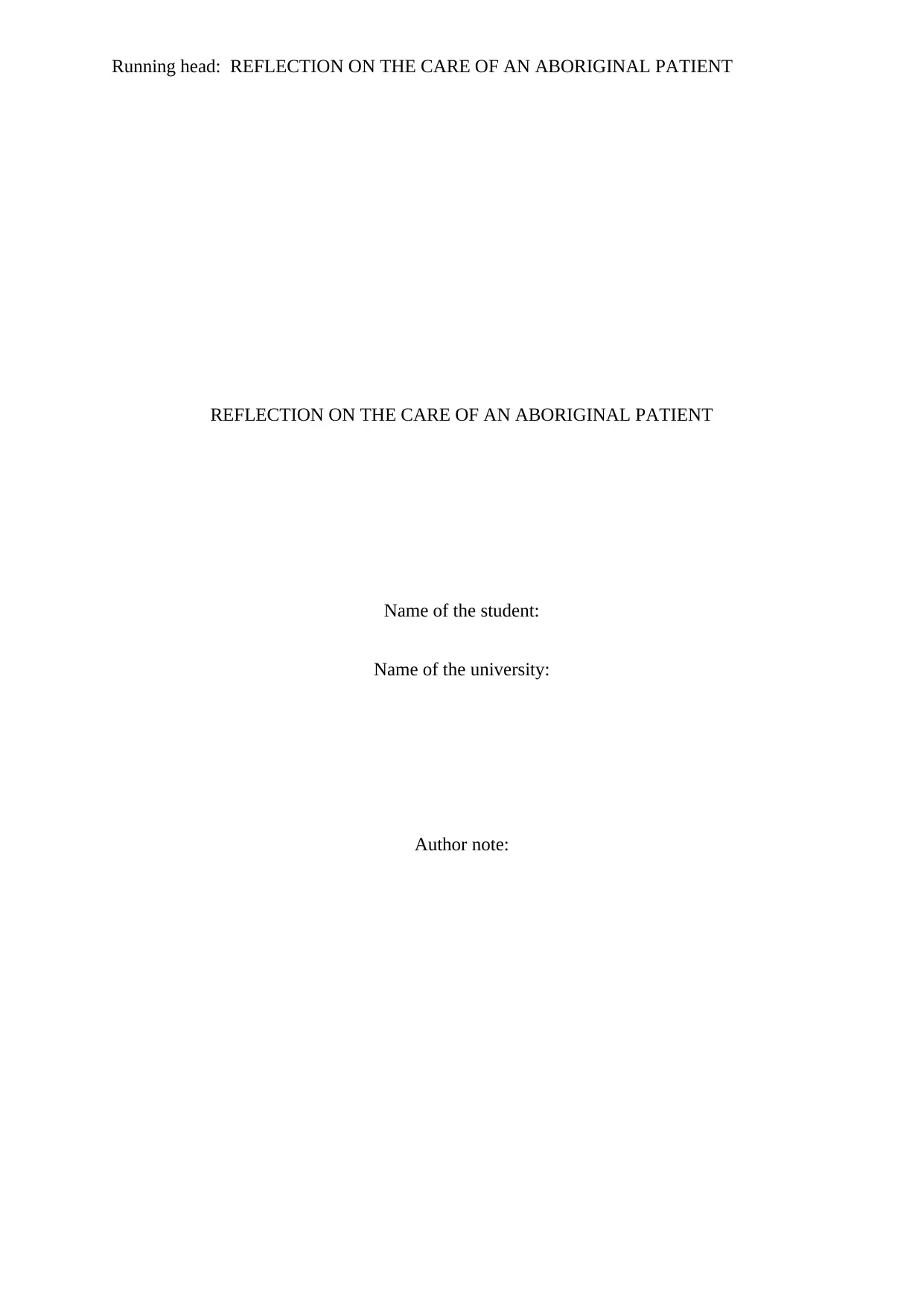
Running head: REFLECTION ON THE CARE OF AN ABORIGINAL PATIENT
REFLECTION ON THE CARE OF AN ABORIGINAL PATIENT
Name of the student:
Name of the university:
Author note:
REFLECTION ON THE CARE OF AN ABORIGINAL PATIENT
Name of the student:
Name of the university:
Author note:
Paraphrase This Document
Need a fresh take? Get an instant paraphrase of this document with our AI Paraphraser
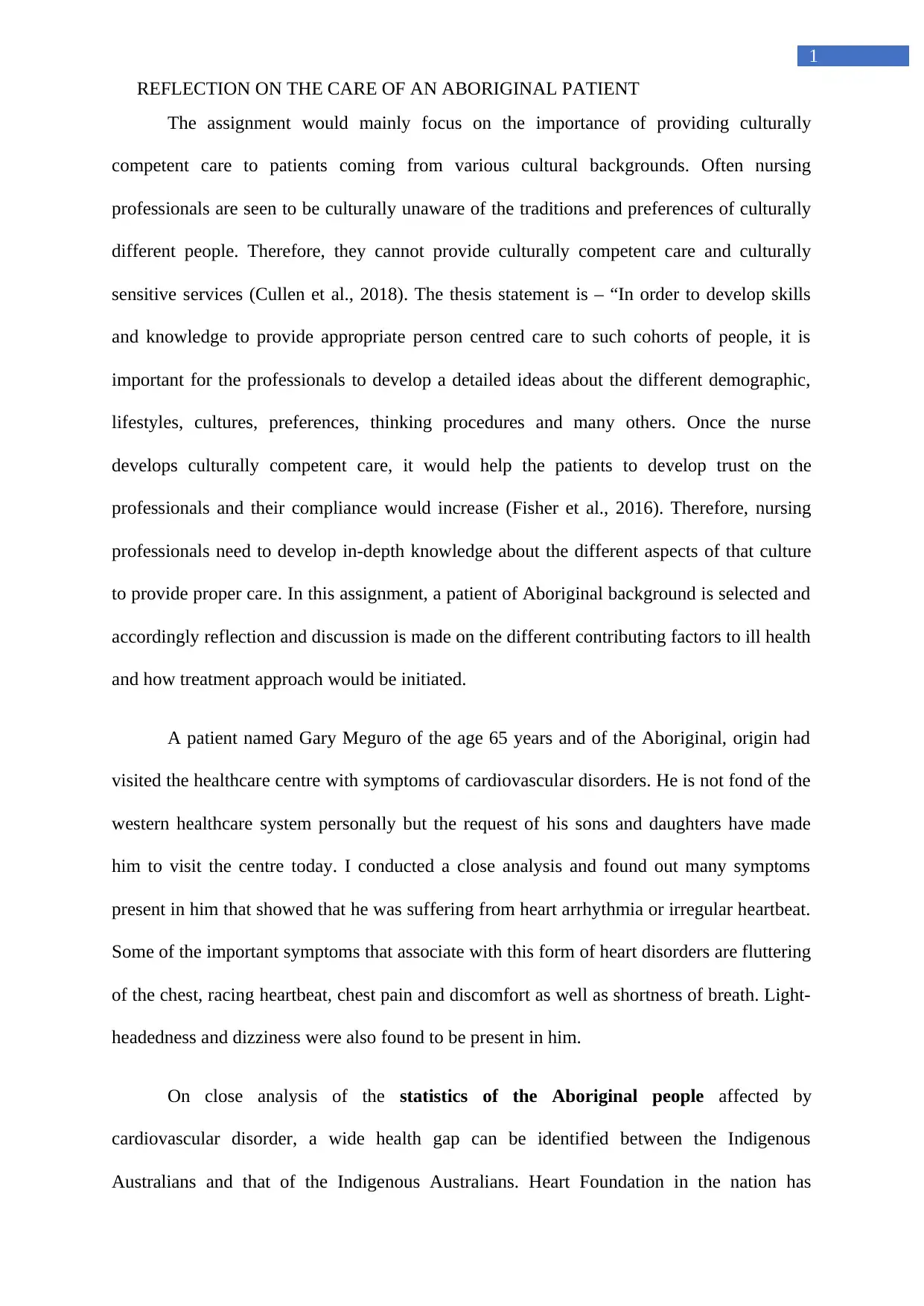
1
REFLECTION ON THE CARE OF AN ABORIGINAL PATIENT
The assignment would mainly focus on the importance of providing culturally
competent care to patients coming from various cultural backgrounds. Often nursing
professionals are seen to be culturally unaware of the traditions and preferences of culturally
different people. Therefore, they cannot provide culturally competent care and culturally
sensitive services (Cullen et al., 2018). The thesis statement is – “In order to develop skills
and knowledge to provide appropriate person centred care to such cohorts of people, it is
important for the professionals to develop a detailed ideas about the different demographic,
lifestyles, cultures, preferences, thinking procedures and many others. Once the nurse
develops culturally competent care, it would help the patients to develop trust on the
professionals and their compliance would increase (Fisher et al., 2016). Therefore, nursing
professionals need to develop in-depth knowledge about the different aspects of that culture
to provide proper care. In this assignment, a patient of Aboriginal background is selected and
accordingly reflection and discussion is made on the different contributing factors to ill health
and how treatment approach would be initiated.
A patient named Gary Meguro of the age 65 years and of the Aboriginal, origin had
visited the healthcare centre with symptoms of cardiovascular disorders. He is not fond of the
western healthcare system personally but the request of his sons and daughters have made
him to visit the centre today. I conducted a close analysis and found out many symptoms
present in him that showed that he was suffering from heart arrhythmia or irregular heartbeat.
Some of the important symptoms that associate with this form of heart disorders are fluttering
of the chest, racing heartbeat, chest pain and discomfort as well as shortness of breath. Light-
headedness and dizziness were also found to be present in him.
On close analysis of the statistics of the Aboriginal people affected by
cardiovascular disorder, a wide health gap can be identified between the Indigenous
Australians and that of the Indigenous Australians. Heart Foundation in the nation has
REFLECTION ON THE CARE OF AN ABORIGINAL PATIENT
The assignment would mainly focus on the importance of providing culturally
competent care to patients coming from various cultural backgrounds. Often nursing
professionals are seen to be culturally unaware of the traditions and preferences of culturally
different people. Therefore, they cannot provide culturally competent care and culturally
sensitive services (Cullen et al., 2018). The thesis statement is – “In order to develop skills
and knowledge to provide appropriate person centred care to such cohorts of people, it is
important for the professionals to develop a detailed ideas about the different demographic,
lifestyles, cultures, preferences, thinking procedures and many others. Once the nurse
develops culturally competent care, it would help the patients to develop trust on the
professionals and their compliance would increase (Fisher et al., 2016). Therefore, nursing
professionals need to develop in-depth knowledge about the different aspects of that culture
to provide proper care. In this assignment, a patient of Aboriginal background is selected and
accordingly reflection and discussion is made on the different contributing factors to ill health
and how treatment approach would be initiated.
A patient named Gary Meguro of the age 65 years and of the Aboriginal, origin had
visited the healthcare centre with symptoms of cardiovascular disorders. He is not fond of the
western healthcare system personally but the request of his sons and daughters have made
him to visit the centre today. I conducted a close analysis and found out many symptoms
present in him that showed that he was suffering from heart arrhythmia or irregular heartbeat.
Some of the important symptoms that associate with this form of heart disorders are fluttering
of the chest, racing heartbeat, chest pain and discomfort as well as shortness of breath. Light-
headedness and dizziness were also found to be present in him.
On close analysis of the statistics of the Aboriginal people affected by
cardiovascular disorder, a wide health gap can be identified between the Indigenous
Australians and that of the Indigenous Australians. Heart Foundation in the nation has
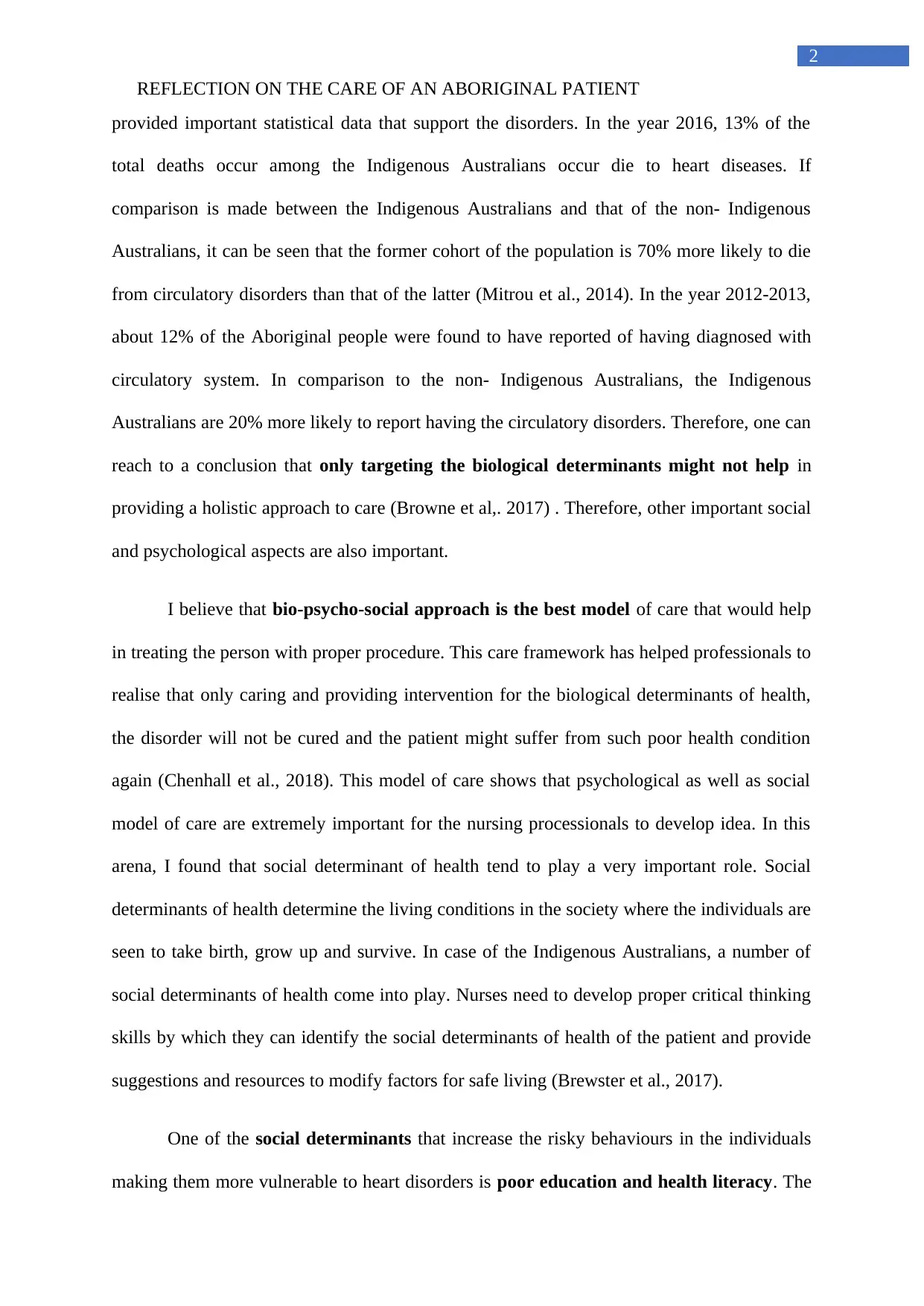
2
REFLECTION ON THE CARE OF AN ABORIGINAL PATIENT
provided important statistical data that support the disorders. In the year 2016, 13% of the
total deaths occur among the Indigenous Australians occur die to heart diseases. If
comparison is made between the Indigenous Australians and that of the non- Indigenous
Australians, it can be seen that the former cohort of the population is 70% more likely to die
from circulatory disorders than that of the latter (Mitrou et al., 2014). In the year 2012-2013,
about 12% of the Aboriginal people were found to have reported of having diagnosed with
circulatory system. In comparison to the non- Indigenous Australians, the Indigenous
Australians are 20% more likely to report having the circulatory disorders. Therefore, one can
reach to a conclusion that only targeting the biological determinants might not help in
providing a holistic approach to care (Browne et al,. 2017) . Therefore, other important social
and psychological aspects are also important.
I believe that bio-psycho-social approach is the best model of care that would help
in treating the person with proper procedure. This care framework has helped professionals to
realise that only caring and providing intervention for the biological determinants of health,
the disorder will not be cured and the patient might suffer from such poor health condition
again (Chenhall et al., 2018). This model of care shows that psychological as well as social
model of care are extremely important for the nursing processionals to develop idea. In this
arena, I found that social determinant of health tend to play a very important role. Social
determinants of health determine the living conditions in the society where the individuals are
seen to take birth, grow up and survive. In case of the Indigenous Australians, a number of
social determinants of health come into play. Nurses need to develop proper critical thinking
skills by which they can identify the social determinants of health of the patient and provide
suggestions and resources to modify factors for safe living (Brewster et al., 2017).
One of the social determinants that increase the risky behaviours in the individuals
making them more vulnerable to heart disorders is poor education and health literacy. The
REFLECTION ON THE CARE OF AN ABORIGINAL PATIENT
provided important statistical data that support the disorders. In the year 2016, 13% of the
total deaths occur among the Indigenous Australians occur die to heart diseases. If
comparison is made between the Indigenous Australians and that of the non- Indigenous
Australians, it can be seen that the former cohort of the population is 70% more likely to die
from circulatory disorders than that of the latter (Mitrou et al., 2014). In the year 2012-2013,
about 12% of the Aboriginal people were found to have reported of having diagnosed with
circulatory system. In comparison to the non- Indigenous Australians, the Indigenous
Australians are 20% more likely to report having the circulatory disorders. Therefore, one can
reach to a conclusion that only targeting the biological determinants might not help in
providing a holistic approach to care (Browne et al,. 2017) . Therefore, other important social
and psychological aspects are also important.
I believe that bio-psycho-social approach is the best model of care that would help
in treating the person with proper procedure. This care framework has helped professionals to
realise that only caring and providing intervention for the biological determinants of health,
the disorder will not be cured and the patient might suffer from such poor health condition
again (Chenhall et al., 2018). This model of care shows that psychological as well as social
model of care are extremely important for the nursing processionals to develop idea. In this
arena, I found that social determinant of health tend to play a very important role. Social
determinants of health determine the living conditions in the society where the individuals are
seen to take birth, grow up and survive. In case of the Indigenous Australians, a number of
social determinants of health come into play. Nurses need to develop proper critical thinking
skills by which they can identify the social determinants of health of the patient and provide
suggestions and resources to modify factors for safe living (Brewster et al., 2017).
One of the social determinants that increase the risky behaviours in the individuals
making them more vulnerable to heart disorders is poor education and health literacy. The
⊘ This is a preview!⊘
Do you want full access?
Subscribe today to unlock all pages.

Trusted by 1+ million students worldwide
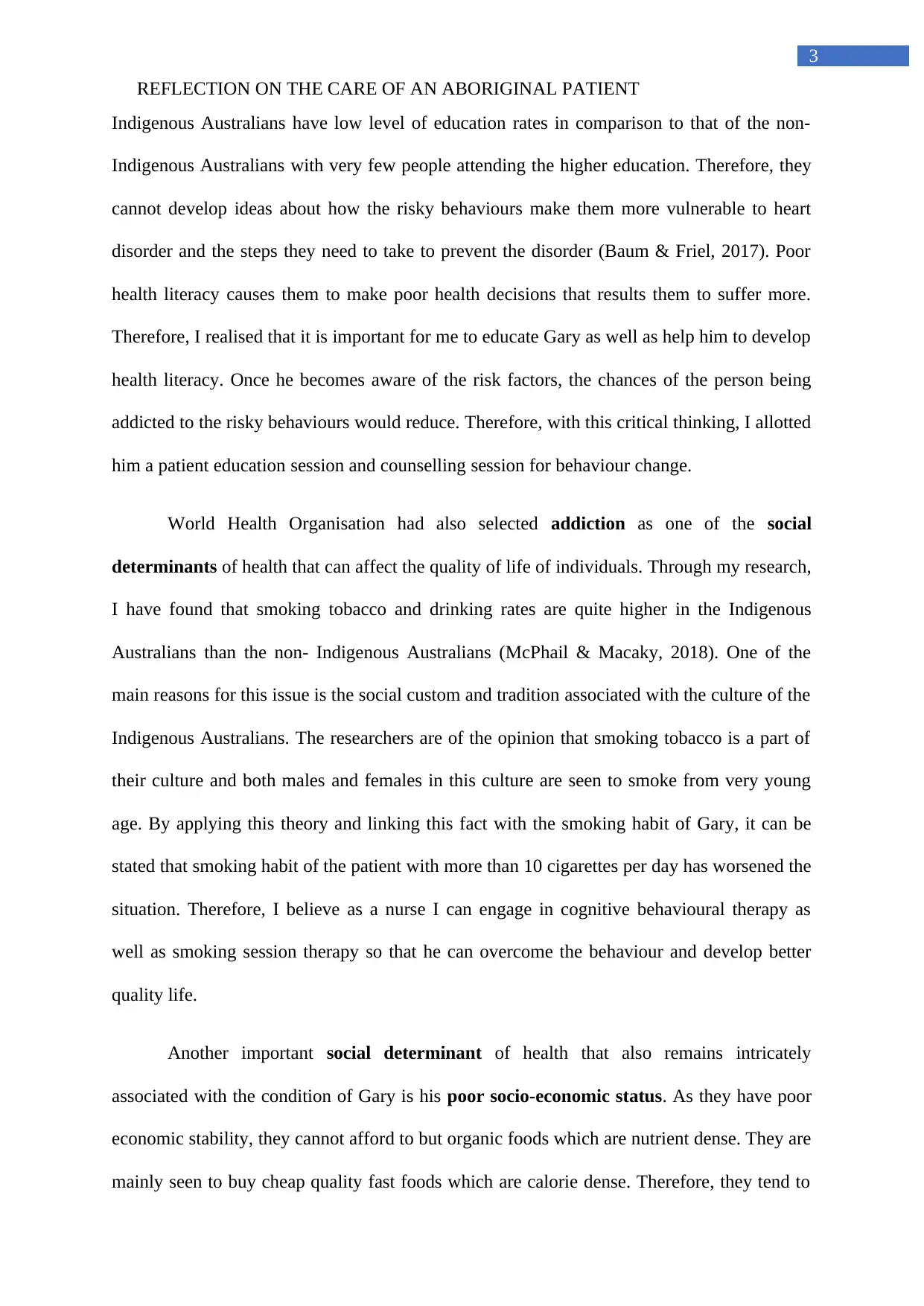
3
REFLECTION ON THE CARE OF AN ABORIGINAL PATIENT
Indigenous Australians have low level of education rates in comparison to that of the non-
Indigenous Australians with very few people attending the higher education. Therefore, they
cannot develop ideas about how the risky behaviours make them more vulnerable to heart
disorder and the steps they need to take to prevent the disorder (Baum & Friel, 2017). Poor
health literacy causes them to make poor health decisions that results them to suffer more.
Therefore, I realised that it is important for me to educate Gary as well as help him to develop
health literacy. Once he becomes aware of the risk factors, the chances of the person being
addicted to the risky behaviours would reduce. Therefore, with this critical thinking, I allotted
him a patient education session and counselling session for behaviour change.
World Health Organisation had also selected addiction as one of the social
determinants of health that can affect the quality of life of individuals. Through my research,
I have found that smoking tobacco and drinking rates are quite higher in the Indigenous
Australians than the non- Indigenous Australians (McPhail & Macaky, 2018). One of the
main reasons for this issue is the social custom and tradition associated with the culture of the
Indigenous Australians. The researchers are of the opinion that smoking tobacco is a part of
their culture and both males and females in this culture are seen to smoke from very young
age. By applying this theory and linking this fact with the smoking habit of Gary, it can be
stated that smoking habit of the patient with more than 10 cigarettes per day has worsened the
situation. Therefore, I believe as a nurse I can engage in cognitive behavioural therapy as
well as smoking session therapy so that he can overcome the behaviour and develop better
quality life.
Another important social determinant of health that also remains intricately
associated with the condition of Gary is his poor socio-economic status. As they have poor
economic stability, they cannot afford to but organic foods which are nutrient dense. They are
mainly seen to buy cheap quality fast foods which are calorie dense. Therefore, they tend to
REFLECTION ON THE CARE OF AN ABORIGINAL PATIENT
Indigenous Australians have low level of education rates in comparison to that of the non-
Indigenous Australians with very few people attending the higher education. Therefore, they
cannot develop ideas about how the risky behaviours make them more vulnerable to heart
disorder and the steps they need to take to prevent the disorder (Baum & Friel, 2017). Poor
health literacy causes them to make poor health decisions that results them to suffer more.
Therefore, I realised that it is important for me to educate Gary as well as help him to develop
health literacy. Once he becomes aware of the risk factors, the chances of the person being
addicted to the risky behaviours would reduce. Therefore, with this critical thinking, I allotted
him a patient education session and counselling session for behaviour change.
World Health Organisation had also selected addiction as one of the social
determinants of health that can affect the quality of life of individuals. Through my research,
I have found that smoking tobacco and drinking rates are quite higher in the Indigenous
Australians than the non- Indigenous Australians (McPhail & Macaky, 2018). One of the
main reasons for this issue is the social custom and tradition associated with the culture of the
Indigenous Australians. The researchers are of the opinion that smoking tobacco is a part of
their culture and both males and females in this culture are seen to smoke from very young
age. By applying this theory and linking this fact with the smoking habit of Gary, it can be
stated that smoking habit of the patient with more than 10 cigarettes per day has worsened the
situation. Therefore, I believe as a nurse I can engage in cognitive behavioural therapy as
well as smoking session therapy so that he can overcome the behaviour and develop better
quality life.
Another important social determinant of health that also remains intricately
associated with the condition of Gary is his poor socio-economic status. As they have poor
economic stability, they cannot afford to but organic foods which are nutrient dense. They are
mainly seen to buy cheap quality fast foods which are calorie dense. Therefore, they tend to
Paraphrase This Document
Need a fresh take? Get an instant paraphrase of this document with our AI Paraphraser
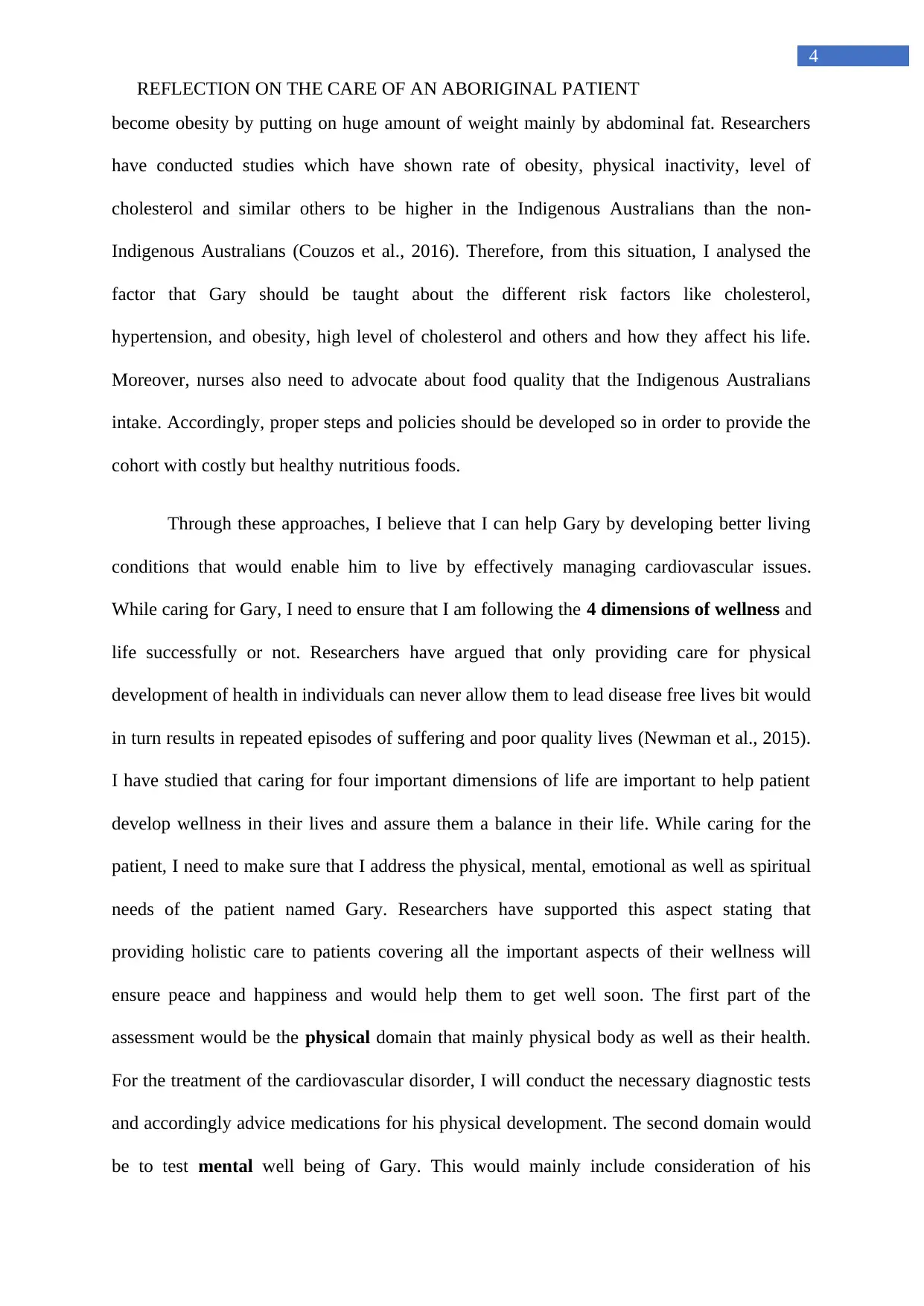
4
REFLECTION ON THE CARE OF AN ABORIGINAL PATIENT
become obesity by putting on huge amount of weight mainly by abdominal fat. Researchers
have conducted studies which have shown rate of obesity, physical inactivity, level of
cholesterol and similar others to be higher in the Indigenous Australians than the non-
Indigenous Australians (Couzos et al., 2016). Therefore, from this situation, I analysed the
factor that Gary should be taught about the different risk factors like cholesterol,
hypertension, and obesity, high level of cholesterol and others and how they affect his life.
Moreover, nurses also need to advocate about food quality that the Indigenous Australians
intake. Accordingly, proper steps and policies should be developed so in order to provide the
cohort with costly but healthy nutritious foods.
Through these approaches, I believe that I can help Gary by developing better living
conditions that would enable him to live by effectively managing cardiovascular issues.
While caring for Gary, I need to ensure that I am following the 4 dimensions of wellness and
life successfully or not. Researchers have argued that only providing care for physical
development of health in individuals can never allow them to lead disease free lives bit would
in turn results in repeated episodes of suffering and poor quality lives (Newman et al., 2015).
I have studied that caring for four important dimensions of life are important to help patient
develop wellness in their lives and assure them a balance in their life. While caring for the
patient, I need to make sure that I address the physical, mental, emotional as well as spiritual
needs of the patient named Gary. Researchers have supported this aspect stating that
providing holistic care to patients covering all the important aspects of their wellness will
ensure peace and happiness and would help them to get well soon. The first part of the
assessment would be the physical domain that mainly physical body as well as their health.
For the treatment of the cardiovascular disorder, I will conduct the necessary diagnostic tests
and accordingly advice medications for his physical development. The second domain would
be to test mental well being of Gary. This would mainly include consideration of his
REFLECTION ON THE CARE OF AN ABORIGINAL PATIENT
become obesity by putting on huge amount of weight mainly by abdominal fat. Researchers
have conducted studies which have shown rate of obesity, physical inactivity, level of
cholesterol and similar others to be higher in the Indigenous Australians than the non-
Indigenous Australians (Couzos et al., 2016). Therefore, from this situation, I analysed the
factor that Gary should be taught about the different risk factors like cholesterol,
hypertension, and obesity, high level of cholesterol and others and how they affect his life.
Moreover, nurses also need to advocate about food quality that the Indigenous Australians
intake. Accordingly, proper steps and policies should be developed so in order to provide the
cohort with costly but healthy nutritious foods.
Through these approaches, I believe that I can help Gary by developing better living
conditions that would enable him to live by effectively managing cardiovascular issues.
While caring for Gary, I need to ensure that I am following the 4 dimensions of wellness and
life successfully or not. Researchers have argued that only providing care for physical
development of health in individuals can never allow them to lead disease free lives bit would
in turn results in repeated episodes of suffering and poor quality lives (Newman et al., 2015).
I have studied that caring for four important dimensions of life are important to help patient
develop wellness in their lives and assure them a balance in their life. While caring for the
patient, I need to make sure that I address the physical, mental, emotional as well as spiritual
needs of the patient named Gary. Researchers have supported this aspect stating that
providing holistic care to patients covering all the important aspects of their wellness will
ensure peace and happiness and would help them to get well soon. The first part of the
assessment would be the physical domain that mainly physical body as well as their health.
For the treatment of the cardiovascular disorder, I will conduct the necessary diagnostic tests
and accordingly advice medications for his physical development. The second domain would
be to test mental well being of Gary. This would mainly include consideration of his
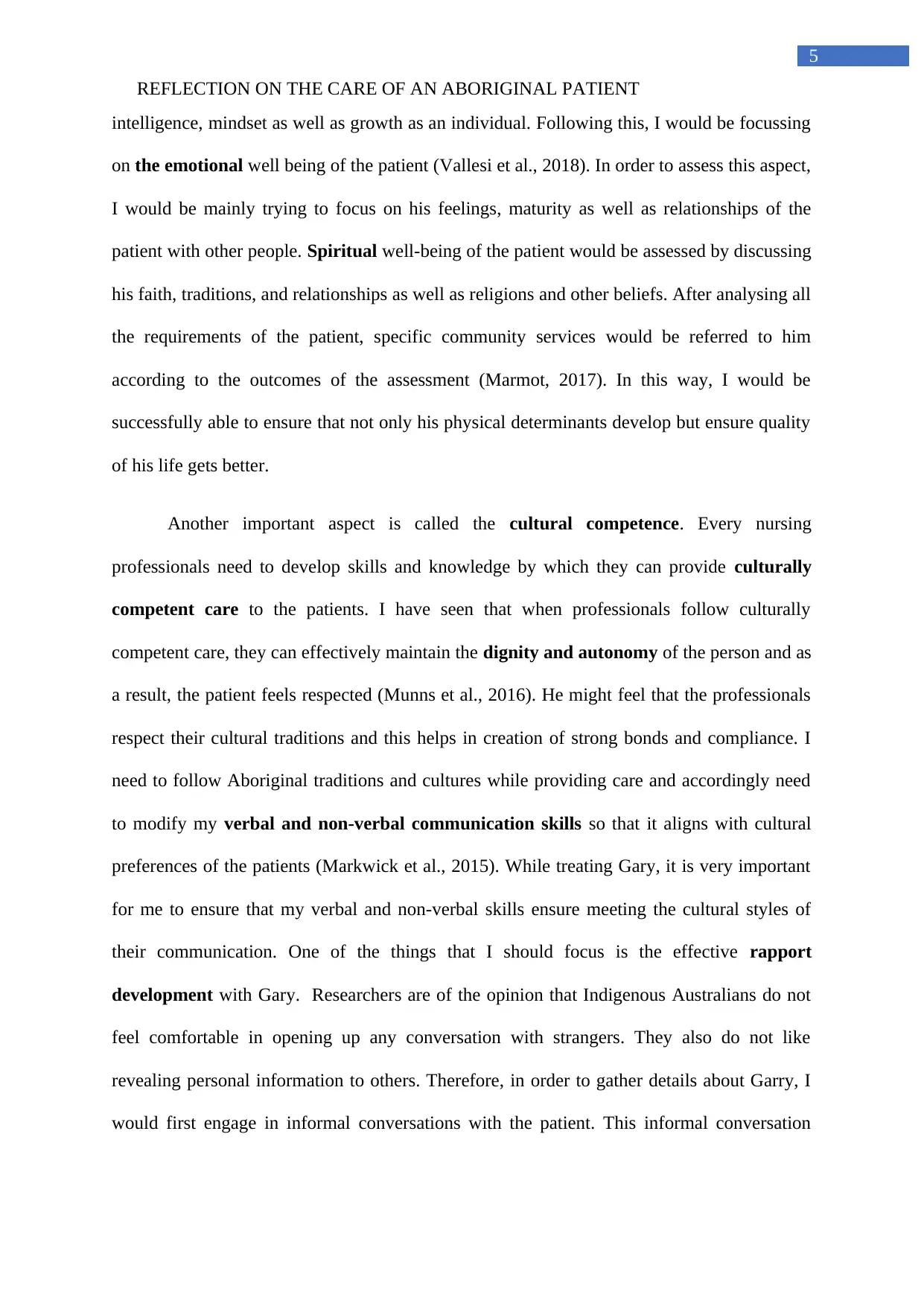
5
REFLECTION ON THE CARE OF AN ABORIGINAL PATIENT
intelligence, mindset as well as growth as an individual. Following this, I would be focussing
on the emotional well being of the patient (Vallesi et al., 2018). In order to assess this aspect,
I would be mainly trying to focus on his feelings, maturity as well as relationships of the
patient with other people. Spiritual well-being of the patient would be assessed by discussing
his faith, traditions, and relationships as well as religions and other beliefs. After analysing all
the requirements of the patient, specific community services would be referred to him
according to the outcomes of the assessment (Marmot, 2017). In this way, I would be
successfully able to ensure that not only his physical determinants develop but ensure quality
of his life gets better.
Another important aspect is called the cultural competence. Every nursing
professionals need to develop skills and knowledge by which they can provide culturally
competent care to the patients. I have seen that when professionals follow culturally
competent care, they can effectively maintain the dignity and autonomy of the person and as
a result, the patient feels respected (Munns et al., 2016). He might feel that the professionals
respect their cultural traditions and this helps in creation of strong bonds and compliance. I
need to follow Aboriginal traditions and cultures while providing care and accordingly need
to modify my verbal and non-verbal communication skills so that it aligns with cultural
preferences of the patients (Markwick et al., 2015). While treating Gary, it is very important
for me to ensure that my verbal and non-verbal skills ensure meeting the cultural styles of
their communication. One of the things that I should focus is the effective rapport
development with Gary. Researchers are of the opinion that Indigenous Australians do not
feel comfortable in opening up any conversation with strangers. They also do not like
revealing personal information to others. Therefore, in order to gather details about Garry, I
would first engage in informal conversations with the patient. This informal conversation
REFLECTION ON THE CARE OF AN ABORIGINAL PATIENT
intelligence, mindset as well as growth as an individual. Following this, I would be focussing
on the emotional well being of the patient (Vallesi et al., 2018). In order to assess this aspect,
I would be mainly trying to focus on his feelings, maturity as well as relationships of the
patient with other people. Spiritual well-being of the patient would be assessed by discussing
his faith, traditions, and relationships as well as religions and other beliefs. After analysing all
the requirements of the patient, specific community services would be referred to him
according to the outcomes of the assessment (Marmot, 2017). In this way, I would be
successfully able to ensure that not only his physical determinants develop but ensure quality
of his life gets better.
Another important aspect is called the cultural competence. Every nursing
professionals need to develop skills and knowledge by which they can provide culturally
competent care to the patients. I have seen that when professionals follow culturally
competent care, they can effectively maintain the dignity and autonomy of the person and as
a result, the patient feels respected (Munns et al., 2016). He might feel that the professionals
respect their cultural traditions and this helps in creation of strong bonds and compliance. I
need to follow Aboriginal traditions and cultures while providing care and accordingly need
to modify my verbal and non-verbal communication skills so that it aligns with cultural
preferences of the patients (Markwick et al., 2015). While treating Gary, it is very important
for me to ensure that my verbal and non-verbal skills ensure meeting the cultural styles of
their communication. One of the things that I should focus is the effective rapport
development with Gary. Researchers are of the opinion that Indigenous Australians do not
feel comfortable in opening up any conversation with strangers. They also do not like
revealing personal information to others. Therefore, in order to gather details about Garry, I
would first engage in informal conversations with the patient. This informal conversation
⊘ This is a preview!⊘
Do you want full access?
Subscribe today to unlock all pages.

Trusted by 1+ million students worldwide
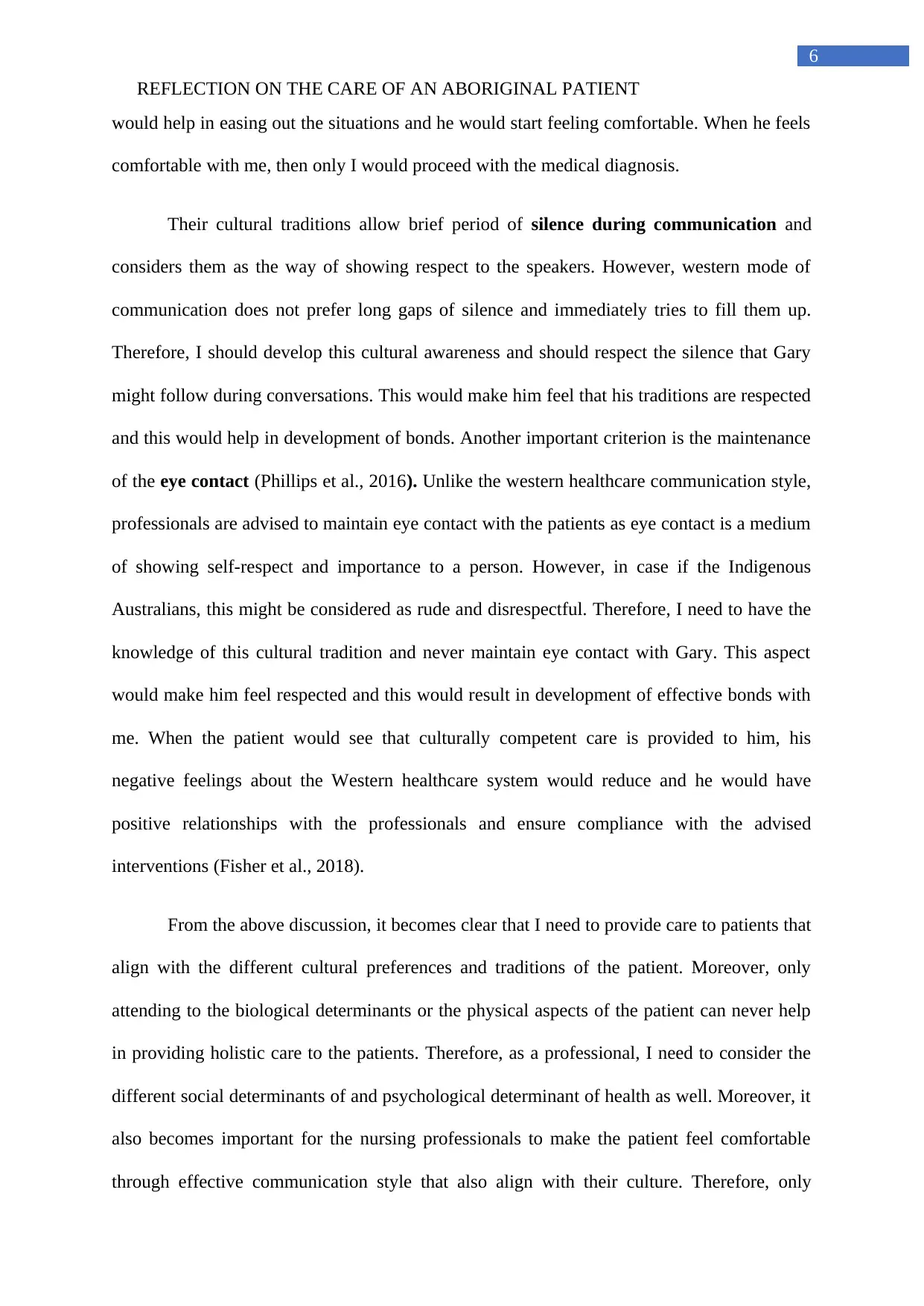
6
REFLECTION ON THE CARE OF AN ABORIGINAL PATIENT
would help in easing out the situations and he would start feeling comfortable. When he feels
comfortable with me, then only I would proceed with the medical diagnosis.
Their cultural traditions allow brief period of silence during communication and
considers them as the way of showing respect to the speakers. However, western mode of
communication does not prefer long gaps of silence and immediately tries to fill them up.
Therefore, I should develop this cultural awareness and should respect the silence that Gary
might follow during conversations. This would make him feel that his traditions are respected
and this would help in development of bonds. Another important criterion is the maintenance
of the eye contact (Phillips et al., 2016). Unlike the western healthcare communication style,
professionals are advised to maintain eye contact with the patients as eye contact is a medium
of showing self-respect and importance to a person. However, in case if the Indigenous
Australians, this might be considered as rude and disrespectful. Therefore, I need to have the
knowledge of this cultural tradition and never maintain eye contact with Gary. This aspect
would make him feel respected and this would result in development of effective bonds with
me. When the patient would see that culturally competent care is provided to him, his
negative feelings about the Western healthcare system would reduce and he would have
positive relationships with the professionals and ensure compliance with the advised
interventions (Fisher et al., 2018).
From the above discussion, it becomes clear that I need to provide care to patients that
align with the different cultural preferences and traditions of the patient. Moreover, only
attending to the biological determinants or the physical aspects of the patient can never help
in providing holistic care to the patients. Therefore, as a professional, I need to consider the
different social determinants of and psychological determinant of health as well. Moreover, it
also becomes important for the nursing professionals to make the patient feel comfortable
through effective communication style that also align with their culture. Therefore, only
REFLECTION ON THE CARE OF AN ABORIGINAL PATIENT
would help in easing out the situations and he would start feeling comfortable. When he feels
comfortable with me, then only I would proceed with the medical diagnosis.
Their cultural traditions allow brief period of silence during communication and
considers them as the way of showing respect to the speakers. However, western mode of
communication does not prefer long gaps of silence and immediately tries to fill them up.
Therefore, I should develop this cultural awareness and should respect the silence that Gary
might follow during conversations. This would make him feel that his traditions are respected
and this would help in development of bonds. Another important criterion is the maintenance
of the eye contact (Phillips et al., 2016). Unlike the western healthcare communication style,
professionals are advised to maintain eye contact with the patients as eye contact is a medium
of showing self-respect and importance to a person. However, in case if the Indigenous
Australians, this might be considered as rude and disrespectful. Therefore, I need to have the
knowledge of this cultural tradition and never maintain eye contact with Gary. This aspect
would make him feel respected and this would result in development of effective bonds with
me. When the patient would see that culturally competent care is provided to him, his
negative feelings about the Western healthcare system would reduce and he would have
positive relationships with the professionals and ensure compliance with the advised
interventions (Fisher et al., 2018).
From the above discussion, it becomes clear that I need to provide care to patients that
align with the different cultural preferences and traditions of the patient. Moreover, only
attending to the biological determinants or the physical aspects of the patient can never help
in providing holistic care to the patients. Therefore, as a professional, I need to consider the
different social determinants of and psychological determinant of health as well. Moreover, it
also becomes important for the nursing professionals to make the patient feel comfortable
through effective communication style that also align with their culture. Therefore, only
Paraphrase This Document
Need a fresh take? Get an instant paraphrase of this document with our AI Paraphraser
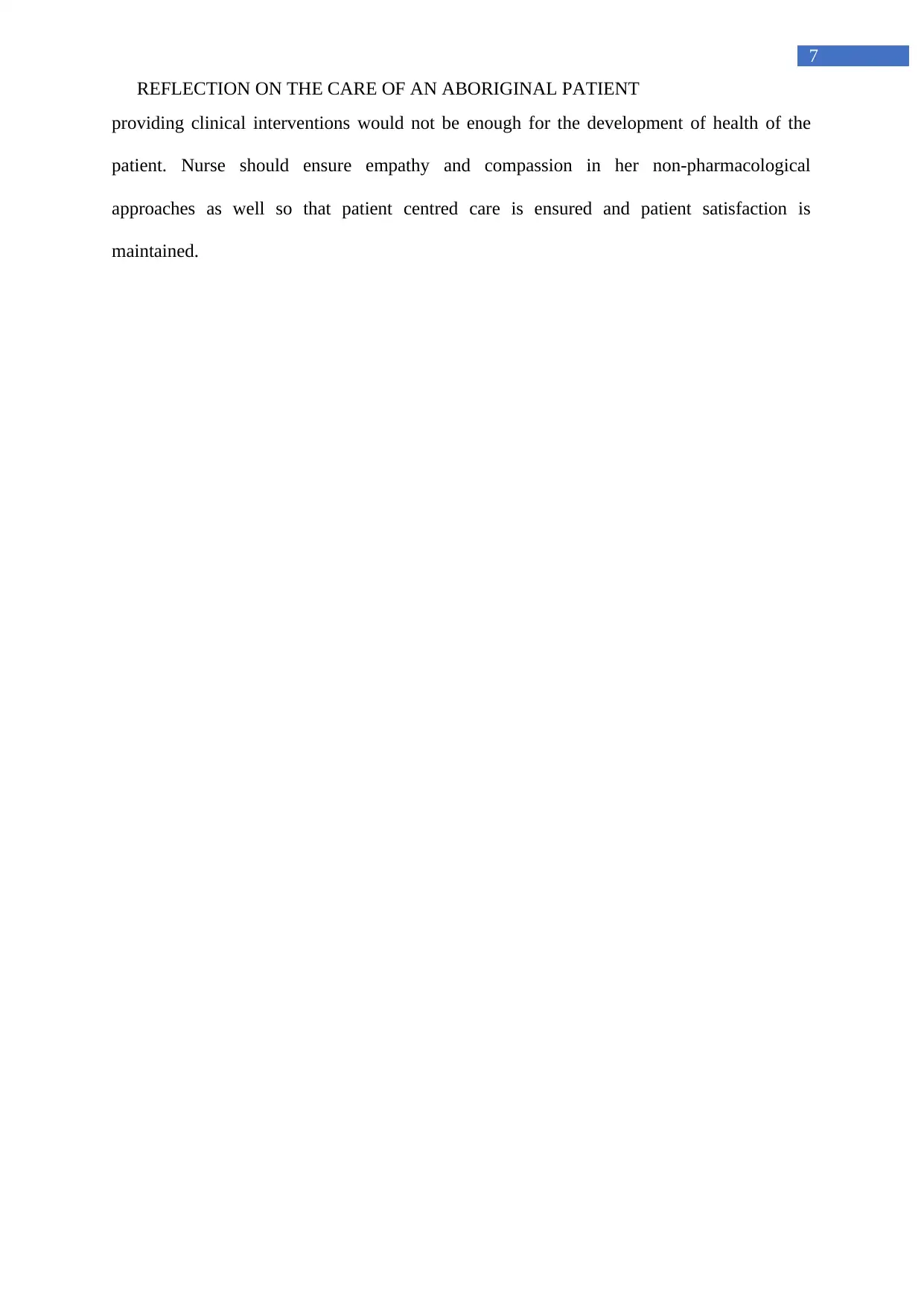
7
REFLECTION ON THE CARE OF AN ABORIGINAL PATIENT
providing clinical interventions would not be enough for the development of health of the
patient. Nurse should ensure empathy and compassion in her non-pharmacological
approaches as well so that patient centred care is ensured and patient satisfaction is
maintained.
REFLECTION ON THE CARE OF AN ABORIGINAL PATIENT
providing clinical interventions would not be enough for the development of health of the
patient. Nurse should ensure empathy and compassion in her non-pharmacological
approaches as well so that patient centred care is ensured and patient satisfaction is
maintained.
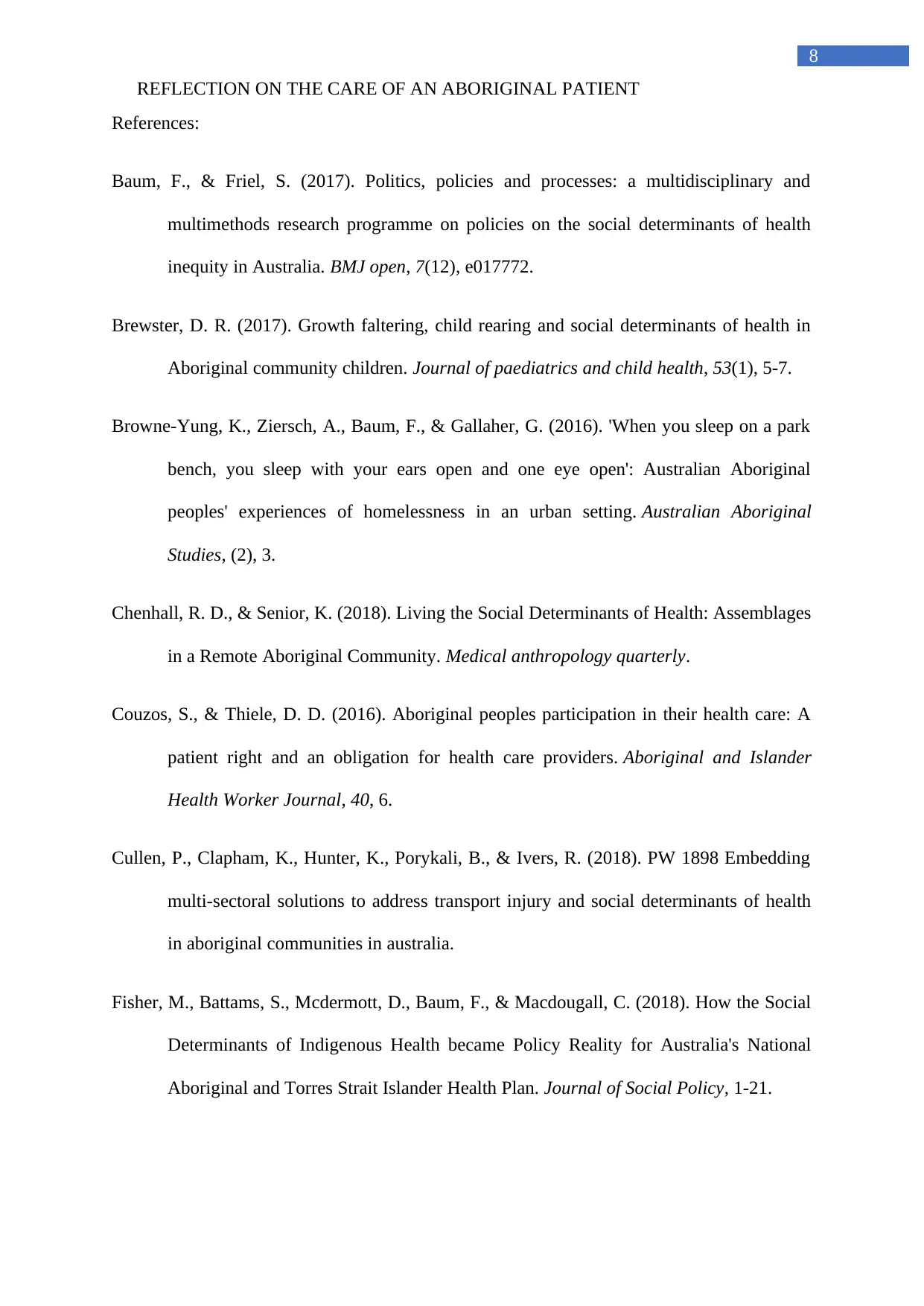
8
REFLECTION ON THE CARE OF AN ABORIGINAL PATIENT
References:
Baum, F., & Friel, S. (2017). Politics, policies and processes: a multidisciplinary and
multimethods research programme on policies on the social determinants of health
inequity in Australia. BMJ open, 7(12), e017772.
Brewster, D. R. (2017). Growth faltering, child rearing and social determinants of health in
Aboriginal community children. Journal of paediatrics and child health, 53(1), 5-7.
Browne-Yung, K., Ziersch, A., Baum, F., & Gallaher, G. (2016). 'When you sleep on a park
bench, you sleep with your ears open and one eye open': Australian Aboriginal
peoples' experiences of homelessness in an urban setting. Australian Aboriginal
Studies, (2), 3.
Chenhall, R. D., & Senior, K. (2018). Living the Social Determinants of Health: Assemblages
in a Remote Aboriginal Community. Medical anthropology quarterly.
Couzos, S., & Thiele, D. D. (2016). Aboriginal peoples participation in their health care: A
patient right and an obligation for health care providers. Aboriginal and Islander
Health Worker Journal, 40, 6.
Cullen, P., Clapham, K., Hunter, K., Porykali, B., & Ivers, R. (2018). PW 1898 Embedding
multi-sectoral solutions to address transport injury and social determinants of health
in aboriginal communities in australia.
Fisher, M., Battams, S., Mcdermott, D., Baum, F., & Macdougall, C. (2018). How the Social
Determinants of Indigenous Health became Policy Reality for Australia's National
Aboriginal and Torres Strait Islander Health Plan. Journal of Social Policy, 1-21.
REFLECTION ON THE CARE OF AN ABORIGINAL PATIENT
References:
Baum, F., & Friel, S. (2017). Politics, policies and processes: a multidisciplinary and
multimethods research programme on policies on the social determinants of health
inequity in Australia. BMJ open, 7(12), e017772.
Brewster, D. R. (2017). Growth faltering, child rearing and social determinants of health in
Aboriginal community children. Journal of paediatrics and child health, 53(1), 5-7.
Browne-Yung, K., Ziersch, A., Baum, F., & Gallaher, G. (2016). 'When you sleep on a park
bench, you sleep with your ears open and one eye open': Australian Aboriginal
peoples' experiences of homelessness in an urban setting. Australian Aboriginal
Studies, (2), 3.
Chenhall, R. D., & Senior, K. (2018). Living the Social Determinants of Health: Assemblages
in a Remote Aboriginal Community. Medical anthropology quarterly.
Couzos, S., & Thiele, D. D. (2016). Aboriginal peoples participation in their health care: A
patient right and an obligation for health care providers. Aboriginal and Islander
Health Worker Journal, 40, 6.
Cullen, P., Clapham, K., Hunter, K., Porykali, B., & Ivers, R. (2018). PW 1898 Embedding
multi-sectoral solutions to address transport injury and social determinants of health
in aboriginal communities in australia.
Fisher, M., Battams, S., Mcdermott, D., Baum, F., & Macdougall, C. (2018). How the Social
Determinants of Indigenous Health became Policy Reality for Australia's National
Aboriginal and Torres Strait Islander Health Plan. Journal of Social Policy, 1-21.
⊘ This is a preview!⊘
Do you want full access?
Subscribe today to unlock all pages.

Trusted by 1+ million students worldwide
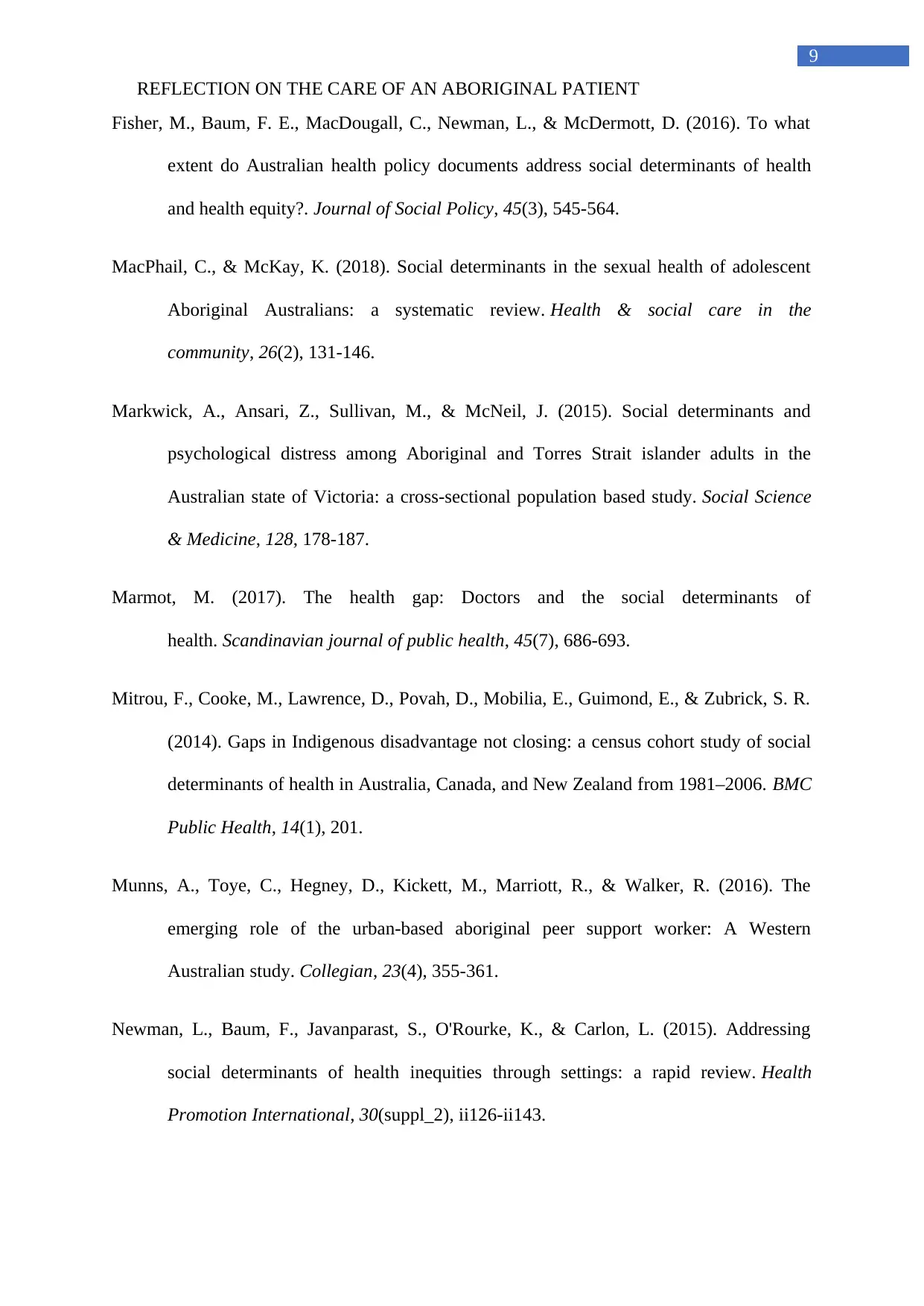
9
REFLECTION ON THE CARE OF AN ABORIGINAL PATIENT
Fisher, M., Baum, F. E., MacDougall, C., Newman, L., & McDermott, D. (2016). To what
extent do Australian health policy documents address social determinants of health
and health equity?. Journal of Social Policy, 45(3), 545-564.
MacPhail, C., & McKay, K. (2018). Social determinants in the sexual health of adolescent
Aboriginal Australians: a systematic review. Health & social care in the
community, 26(2), 131-146.
Markwick, A., Ansari, Z., Sullivan, M., & McNeil, J. (2015). Social determinants and
psychological distress among Aboriginal and Torres Strait islander adults in the
Australian state of Victoria: a cross-sectional population based study. Social Science
& Medicine, 128, 178-187.
Marmot, M. (2017). The health gap: Doctors and the social determinants of
health. Scandinavian journal of public health, 45(7), 686-693.
Mitrou, F., Cooke, M., Lawrence, D., Povah, D., Mobilia, E., Guimond, E., & Zubrick, S. R.
(2014). Gaps in Indigenous disadvantage not closing: a census cohort study of social
determinants of health in Australia, Canada, and New Zealand from 1981–2006. BMC
Public Health, 14(1), 201.
Munns, A., Toye, C., Hegney, D., Kickett, M., Marriott, R., & Walker, R. (2016). The
emerging role of the urban-based aboriginal peer support worker: A Western
Australian study. Collegian, 23(4), 355-361.
Newman, L., Baum, F., Javanparast, S., O'Rourke, K., & Carlon, L. (2015). Addressing
social determinants of health inequities through settings: a rapid review. Health
Promotion International, 30(suppl_2), ii126-ii143.
REFLECTION ON THE CARE OF AN ABORIGINAL PATIENT
Fisher, M., Baum, F. E., MacDougall, C., Newman, L., & McDermott, D. (2016). To what
extent do Australian health policy documents address social determinants of health
and health equity?. Journal of Social Policy, 45(3), 545-564.
MacPhail, C., & McKay, K. (2018). Social determinants in the sexual health of adolescent
Aboriginal Australians: a systematic review. Health & social care in the
community, 26(2), 131-146.
Markwick, A., Ansari, Z., Sullivan, M., & McNeil, J. (2015). Social determinants and
psychological distress among Aboriginal and Torres Strait islander adults in the
Australian state of Victoria: a cross-sectional population based study. Social Science
& Medicine, 128, 178-187.
Marmot, M. (2017). The health gap: Doctors and the social determinants of
health. Scandinavian journal of public health, 45(7), 686-693.
Mitrou, F., Cooke, M., Lawrence, D., Povah, D., Mobilia, E., Guimond, E., & Zubrick, S. R.
(2014). Gaps in Indigenous disadvantage not closing: a census cohort study of social
determinants of health in Australia, Canada, and New Zealand from 1981–2006. BMC
Public Health, 14(1), 201.
Munns, A., Toye, C., Hegney, D., Kickett, M., Marriott, R., & Walker, R. (2016). The
emerging role of the urban-based aboriginal peer support worker: A Western
Australian study. Collegian, 23(4), 355-361.
Newman, L., Baum, F., Javanparast, S., O'Rourke, K., & Carlon, L. (2015). Addressing
social determinants of health inequities through settings: a rapid review. Health
Promotion International, 30(suppl_2), ii126-ii143.
Paraphrase This Document
Need a fresh take? Get an instant paraphrase of this document with our AI Paraphraser
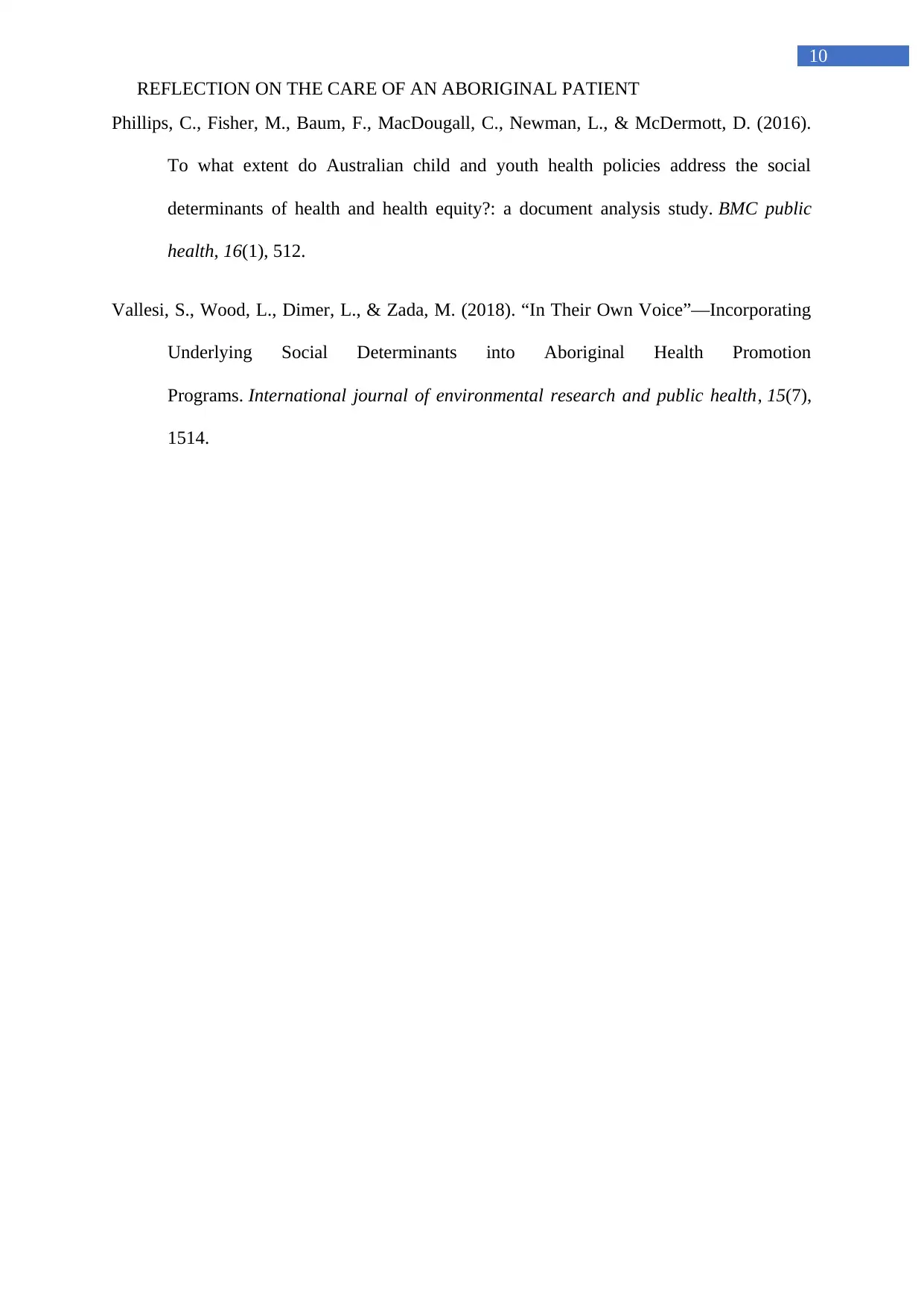
10
REFLECTION ON THE CARE OF AN ABORIGINAL PATIENT
Phillips, C., Fisher, M., Baum, F., MacDougall, C., Newman, L., & McDermott, D. (2016).
To what extent do Australian child and youth health policies address the social
determinants of health and health equity?: a document analysis study. BMC public
health, 16(1), 512.
Vallesi, S., Wood, L., Dimer, L., & Zada, M. (2018). “In Their Own Voice”—Incorporating
Underlying Social Determinants into Aboriginal Health Promotion
Programs. International journal of environmental research and public health, 15(7),
1514.
REFLECTION ON THE CARE OF AN ABORIGINAL PATIENT
Phillips, C., Fisher, M., Baum, F., MacDougall, C., Newman, L., & McDermott, D. (2016).
To what extent do Australian child and youth health policies address the social
determinants of health and health equity?: a document analysis study. BMC public
health, 16(1), 512.
Vallesi, S., Wood, L., Dimer, L., & Zada, M. (2018). “In Their Own Voice”—Incorporating
Underlying Social Determinants into Aboriginal Health Promotion
Programs. International journal of environmental research and public health, 15(7),
1514.
1 out of 11
Related Documents
Your All-in-One AI-Powered Toolkit for Academic Success.
+13062052269
info@desklib.com
Available 24*7 on WhatsApp / Email
![[object Object]](/_next/static/media/star-bottom.7253800d.svg)
Unlock your academic potential
Copyright © 2020–2025 A2Z Services. All Rights Reserved. Developed and managed by ZUCOL.





